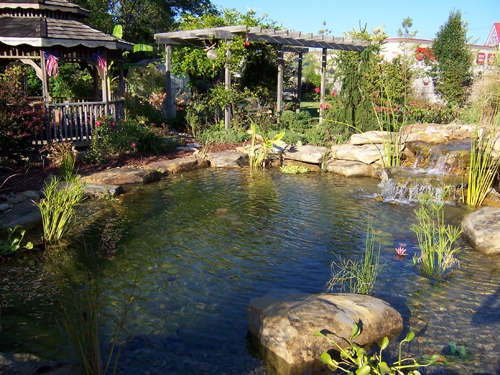[av_textblock size=” font_color=” color=” av-medium-font-size=” av-small-font-size=” av-mini-font-size=” av_uid=’av-l6qomp92′ custom_class=” admin_preview_bg=”]
Choosing the Right Fish for Your Pond
Choosing the right fish for your pond is crucial to ensure a harmonious and healthy aquatic environment. Several factors should be considered, including the type of pond, maintenance requirements, fish compatibility, and the well-being of the fish. Here are some guidelines to help you select suitable fish species for different types of ponds:
-
Koi Ponds
- Koi fish are popular choices for ornamental ponds due to their vibrant colors and graceful swimming patterns.
- Koi require larger ponds with a minimum depth of 3 feet to accommodate their growth and provide adequate swimming space.
- Maintain good water quality by installing a filtration system and regular water testing.
- Avoid overcrowding the pond to prevent stress and disease. A general guideline is to allow at least 250 gallons of water per mature koi.
- Provide hiding places, such as rocks or vegetation, to offer shade and protection.
-
Goldfish Ponds
- Goldfish are hardy, colorful, and well-suited for ponds of various sizes.
- They can tolerate a wider range of water conditions compared to koi.
- Ensure a minimum depth of 2 feet to protect goldfish from predators and provide sufficient space for growth.
- Goldfish produce more waste than koi, so efficient filtration and regular water changes are important.
- Avoid mixing fancy goldfish (with flowing fins) and single-tail goldfish, as the fancy variety may struggle to compete for food.
-
Native Fish Ponds
- Consider stocking your pond with native fish species that are adapted to the local climate and ecosystem.
- Research local regulations regarding collection and stocking of native fish.
- Native fish are generally hardy and require less maintenance.
- Provide natural vegetation, rocks, and logs for shelter and spawning areas.
- Consider adding aquatic plants to enhance the ecosystem and provide additional hiding spots for fish.
-
Tropical Fish Ponds
- Tropical fish ponds are ideal for warmer climates or indoor settings.
- Choose tropical fish species that can tolerate the temperature and water conditions of your region.
- Maintain stable water temperature, ideally between 75-80°F (24-27°C), using a heater or natural means.
- Ensure good water circulation and filtration to maintain water quality.
- Consider the compatibility of different tropical fish species and avoid aggressive or predatory species.
General Tips for Ensuring Fish Health and Well-being
- Quarantine new fish before introducing them to the pond to prevent the spread of diseases.
- Avoid overfeeding to maintain good water quality and prevent obesity-related health issues.
- Monitor water parameters regularly, including temperature, pH, ammonia, nitrite, and nitrate levels.
- Perform regular water changes to dilute toxins and maintain optimal water quality.
- Provide proper nutrition with a balanced fish diet, including high-quality commercial fish food.
- Learn about common diseases and symptoms to identify and treat health issues promptly.
- Avoid introducing non-native or invasive fish species that can disrupt the local ecosystem.
Remember to research specific fish species thoroughly to understand their specific requirements, compatibility, and potential challenges. Consulting with a local aquatic expert or a reputable fish supplier can also provide valuable insights and recommendations tailored to your pond’s unique characteristics.
[/av_textblock]
[av_image src=’https://aquascapes.com/wp-content/uploads/2014/02/2015-ponds-164.jpg’ attachment=’6461′ attachment_size=’full’ align=’center’ styling=” hover=” link=” target=” caption=” font_size=” appearance=” overlay_opacity=’0.4′ overlay_color=’#000000′ overlay_text_color=’#ffffff’ copyright=” animation=’no-animation’ av_uid=’av-ljiy85w4′ custom_class=” admin_preview_bg=”][/av_image]
[av_one_full first min_height=” vertical_alignment=” space=” custom_margin=” margin=’0px’ link=” linktarget=” link_hover=” padding=’0px’ border=” border_color=” radius=’0px’ background=’bg_color’ background_color=” background_gradient_color1=” background_gradient_color2=” background_gradient_direction=’vertical’ src=” background_position=’top left’ background_repeat=’no-repeat’ animation=” mobile_breaking=” mobile_display=” av_uid=’av-10y8z8n’]
[av_textblock size=” font_color=” color=” av-medium-font-size=” av-small-font-size=” av-mini-font-size=” av_uid=’av-108iu6v’ custom_class=” admin_preview_bg=”]
Check out our store for all your water gardening needs! Aquascape products are Aquascape Inc. Certified.
Thanks for reading at Meyer Aquascapes! We hope you’ve enjoyed our post on garden pond design. Please leave a comment below if you liked it or have any questions. We’d love to hear from you! Thanks for stopping by!
[/av_textblock]
[/av_one_full]
[av_hr class=’short’ height=’50’ shadow=’no-shadow’ position=’center’ custom_border=’av-border-thin’ custom_width=’50px’ custom_border_color=” custom_margin_top=’30px’ custom_margin_bottom=’30px’ icon_select=’yes’ custom_icon_color=” icon=’ue808′ font=’entypo-fontello’ av_uid=’av-4bnqpz’ admin_preview_bg=”]
[av_heading heading=’How can we help?’ tag=’h1′ link_apply=” link=” link_target=” style=’blockquote modern-quote modern-centered’ size=” subheading_active=” subheading_size=’15’ margin=” padding=’10’ color=” custom_font=” custom_class=” admin_preview_bg=” av-desktop-hide=” av-medium-hide=” av-small-hide=” av-mini-hide=” av-medium-font-size-title=” av-small-font-size-title=” av-mini-font-size-title=” av-medium-font-size=” av-small-font-size=” av-mini-font-size=”][/av_heading]
[av_textblock size=” font_color=” color=” av-desktop-hide=” av-medium-hide=” av-small-hide=” av-mini-hide=” av-medium-font-size=” av-small-font-size=” av-mini-font-size=” av_uid=’av-334avi’]
[/av_textblock]

